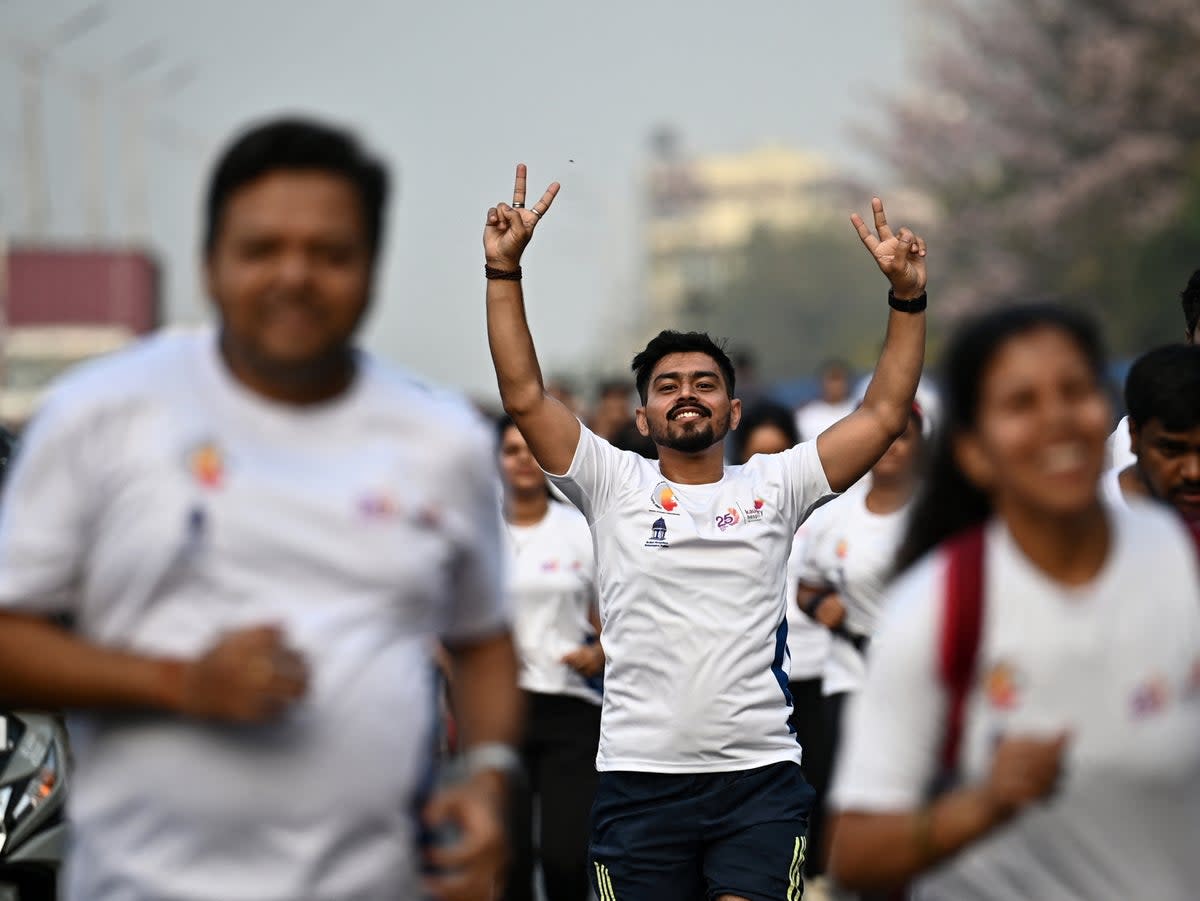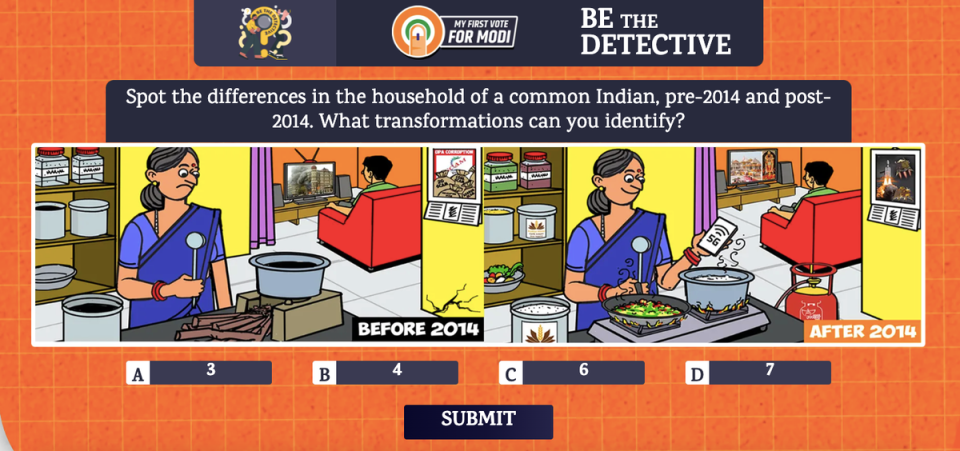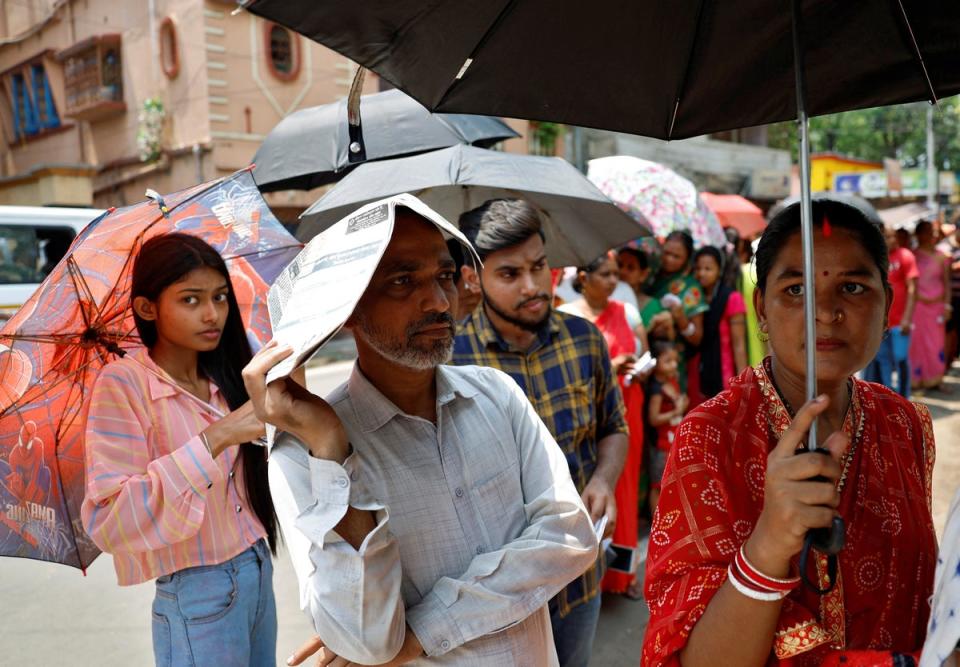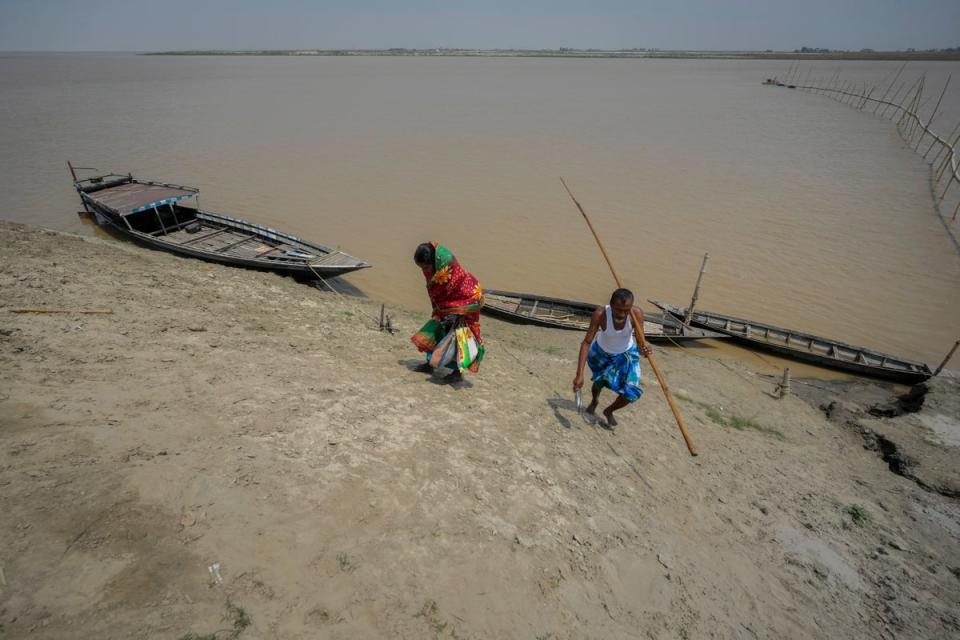Modi courts millions of first-time voters as BJP election momentum falters

The Instagram video begins with a stern-looking cartoon of Narendra Modi staring down the barrel of the camera, appealing for Indians to lend him their “massive support at this hour”. With stirring music and an impassioned voice-over, it uses menacing-looking caricatures of sword-wielding Muslims to warn that Modi’s opponents want to “snatch the wealth of non-Muslims” and “distribute it to Muslims, their favourite community”.
The animation was released by the official social media account of Modi’s BJP party with the country’s marathon general election already underway. Though it was later taken down amid public outrage for demonising a minority religion, it mirrors similar messaging in the prime minister’s own rally speeches and was followed by another video on similar themes posted on the party’s Twitter/X profile.
Another reel on the BJP’s Instagram page features a parody of Shark Tank India, the most-watched Hindi-language non-fiction show in the country in the past year, with 12.5 million viewers. In the video, the “contestants” pitching to the judges are India’s main opposition leaders, including Rahul Gandhi of the Congress party. They are mocked by the judges, before being shown a BJP manifesto. At the end of the clip, each judge pledges not an investment, but “my support for Modi”.
Modi was the overwhelming favourite before the start of the election, boasting that his party would win as many as 400 of the 543 seats in the Lok Sabha, the lower house of parliament. But that aura of invincibility has been dented in the first phases of the campaign, partly because of the release and enthusiastic campaigning of key rival Arvind Kejriwal, and partly because of a noticeable dip in turnout compared to the last election.
The BJP, in a possible sign of worry at the way things are progressing, has doubled down on its core messaging to appeal to Hindu nationalists, and is using its formidable digital campaigning machine to reach out to a young demographic. From social media campaigns and videos on YouTube, to leveraging its influence over the Bollywood film industry and star actors, the BJP has spent a sizeable amount of its outsized election budget in pursuit of India’s youth.
There are an estimated 18 million first-time voters registered in India for this election, out of the total of 970 million people who are eligible to vote for their Lok Sabha representative. The number of first-time voters between 18 and 19 years of age has risen by 20 per cent compared with the last time India held a general election in 2019.
Now the BJP is trying to showcase the government’s initiatives in education, health, communication and start-ups via short videos that can capture the attention of impressionable young voters. Using social media extensively, the party has also launched a campaign website called pehlavotemodiko.bjp.org (“Pehla vote modi ko” roughly translates as“First vote to Modi”) to connect with young voters.
On the website, users can play a game entitled “Be the detective: discover the uniqueness of Modi’s new India”. This game consists of two contrasting images, with the caption: “Spot the differences in the household of a common Indian, pre-2014 and post-2014. What transformations can you identify?” It’s a reference to the fact that Modi came to power in the 2014 Lok Sabha elections.
The pre-2014 image shows a man watching a TV showing footage of the 2008 terror attack on the Taj Hotel in Mumbai. A frowning woman is using firewood to cook her meal, a pot containing something black. A calendar on the wall has an image that reads “2G scam”, “coal scam” – references to public scandals under the last government before Modi came to power.

In the post-2014 image, the man is watching a TV showing the inauguration of the controversial Ram temple in Ayodhya. The temple was constructed on the site of a demolished ancient mosque and most political opposition leaders boycotted the temple’s inauguration, arguing that it contradicts the principles of a secular India.
The woman in the image has a phone in her hand which runs on 5G internet. She is cooking on a gas stove and the pots are full of rice and vegetables. The calendar on the wall carries an image of the Indian lunar spacecraft mission, Chandrayaan. Last year, India made history by becoming the first country to land a lunar mission near the Moon’s south pole.
Once you click to find out the “correct” answer, you have to then submit your phone number to know the results – thereby providing the party with your contact details. The website then outlines the “achievements” of the Modi government, such as “India is the first country in the world to land on the south pole of the Moon”; “Under the prime minister’s Garib Kalyan Anna Yojana, [a scheme to ensure food for the poor] more than 81 crore [810 million] beneficiaries are receiving free rations”; “India leads the world in the fastest 5G rollout” and so on. Sanjay Kumar, director of Lokniti, a research programme at the Centre for the Study of Developing Societies in New Delhi, says that political parties have always put a particular focus on first-time voters because they represent a “significant and fluid voting bloc” who are not yet committed to any party.
“If you look at the voters of other age groups, a very large fraction of them are already decided about which party to vote for,” he tells The Independent. “So the fluidity in political choice is likely to be higher among the first-time voters compared to voters of other age groups. As a result, political parties are more keenly interested in mobilising [that] fluidity.”
Historically, youth participation in Indian elections has been lower than in other demographics, especially from 1996 to 2009, but there has been a notable increase in voter turnout among young people since 2014, Kumar noted.
A sample survey by Lokniti earlier this year suggested that at least 70 per cent of first-time voters in Delhi preferred the BJP in federal government. Kumar believes that the prime minister effectively connects with the youth via several means that resonate well with young voters. India’s first-time voters have come of age during Modi’s decade in charge of the country.
“Prime minister Modi has effectively established a direct connection with the youth of India through various means. He engages with them on numerous occasions, such as national events like Independence Day and Republic Day, as well as during significant sporting events involving the Indian cricket and hockey teams,” he says. This direct communication is impactful because, in a large country like India, it is not easy for people to meet their elected representatives, he explains. “The youth see him as a formidable and influential leader compared to other politicians.”

However, Satish Misra, a political analyst and a fellow at the Observer Research Foundation (ORF) doesn’t think the BJP’s tactics for appealing to young people will override their concerns with the state of the economy. Misra tells The Independent that first-time voters “may not feel comfortable with the current political scenario” in the country. He thinks that could affect the election.
There is high unemployment, a major issue among young people entering the jobs market. According to the latest data from the Centre for Monitoring Indian Economy (CMIE), India’s unemployment was 6.8 per cent in January this year. Despite a minor improvement from 8.7 per cent in December, these figures highlight a persistently troubled job market.
Unemployment among people aged 20 to 30 surged in the October-December quarter of 2023. For those aged 20 to 24, unemployment rose to 44.49 per cent from 43.65 per cent in the July-September quarter. For the 25-to-29 age group, unemployment increased to 14.33 per cent from 13.35 per cent in the previous quarter.

At a voting station in Muzaffarnagar in Uttar Pradesh, where polls were conducted during the first phase of the general elections last month, first-time voter Sakshi Verma, 22, tells The Independent that it was a mix of her family’s voting history and social media that helped her make up her mind who to support. She says she voted for the BJP as she felt women were safer in the city now.
Asked whether she felt empowered as a young person to vote differently from her family if she wanted to, she said: “Yes, I think so.”
Her understanding of politics has come from her family though, she admitted. “I listen to my family. We voted for the same party. I see that women feel safe now, there is development.”
While Verma might have voted the same way as her family, more young people than ever in this election will be influenced by what they see online and – given the huge popularity and relative affordability of Indian cinema – what they see on the big screen,
The BJP has a track record under Modi of using cinema to propagate its ideology, or to stir up nationalistic fervour. Films supporting the BJP’s viewpoint receive tax breaks and regulatory leniency, and are strategically released shortly before elections. The blockbuster biopic Swatantrya Veer Savarkar was released on 22 March and features a glowing portrayal of Savarkar, an early 20th century ideologue usually referred to as the father of Hindu nationalism.

Under Modi, films supporting the government in power focus on its welfare initiatives, as well as themes of Hindu nationalism and Hindu-Muslim tensions. For example, Toilet: Ek Prem Katha, aligned Modi with sanitation reforms, and the prime minister publicly praised The Kashmir Files, a historical drama which negatively portrays Kashmiri Muslims.
Nandini Raj, programme officer with the Association for Democratic Reforms (ADR), believes that accurate information provided through social and traditional mass media for young voters is crucial, as they will otherwise simply be influenced by their family background and community relationships. She believes that “to increase the interest of young voters in politics, the political parties should give tickets to young candidates, too”.

She tells The Independent parties should “engage the youth in manifestoes targeting the youth”. She suggests that “political parties can hire more youth for social media management, consultancy, campaign management etc” in order to do so – something the BJP is seen as leading the way on.
Raj notes how politicians are using modern strategies, such as podcasts and YouTube videos, to establish relatability and a personal connection with young voters. “By collaborating on these platforms, politicians aim to convey their messages in ways that resonate more effectively with younger audiences.”
Investment by political parties in such strategies is only likely to grow in the years to come, with Misra noting that while cinema has long been the obvious route for party propaganda, a number of such films this year have flopped at the box office, suggesting they no longer have the same resonance with their audience.

Snigdha Poonam, author of Dreamers, How Young Indians Are Changing Their World, believes that complex forces drive political decisions among young people. She recently produced an exhibition entitled 2024: Notes from a Generation, a series of portraits and accompanying soundscapes capturing the voices of India’s youth, exploring their experiences and aspirations amid the backdrop of significant political and social shifts in the country.
“I think there’s a lot of excitement every election cycle about where the young voters stand because people expect that they will be thinking in a different way about the direction in which the country’s going, being the generation that has the most at stake when it comes to India’s future,” she says.
“I’ve found that young people’s voting choices are very heavily influenced by their families’ voting history and community relations, so to expect that youth in India is a voting bloc looking at its own issues or concerns independent of affinities based on caste or region or religion is somewhat unrealistic.”
But she says that she is noticing a small trend that “young women are becoming more vocal about issues, particularly their frustration with the BJP not doing enough to uphold constitutional values or dismantle the caste system or patriarchy”, which may influence their voting behaviour differently from young men.


